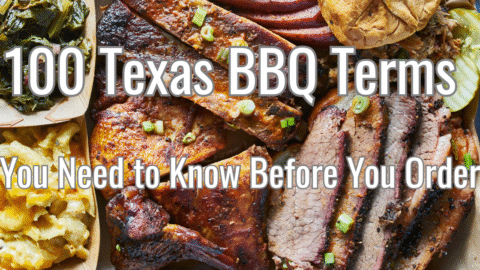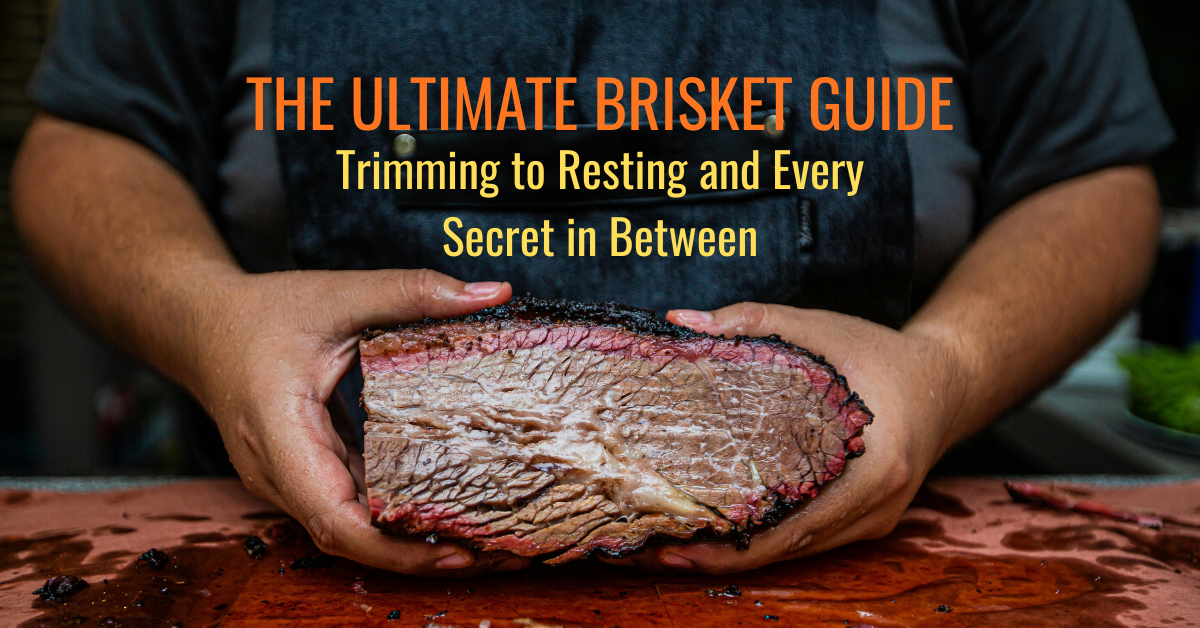Ordering BBQ in Texas can feel like stepping into another world full of words, traditions, and insider language that locals know by heart. If you’ve ever stood at a counter wondering the difference between “moist brisket” and “burnt ends,” or puzzled over why your plate comes with white bread, this guide is for you.
Below is your ultimate Texas BBQ glossary: 100 beginner-friendly terms with definitions, Texas context, and quick pro tips so you can order with confidence, avoid rookie mistakes, and maybe even impress the pitmaster.
Table of Contents
- Meats & Cuts (1–25)
- Cooking Methods & Tools (26–45)
- Ordering & Serving (46–65)
- Seasonings, Sides & Sauce (66–85)
- Culture, Lingo & Regional Styles (86–100)
- Final Thoughts
Meats & Cuts (1–25)
- Brisket — Smoked beef from the chest (point + flat). Pro tip: Ask for a few slices cut pencil-thick to keep them juicy.
- Burnt Ends — Cubed, caramelized brisket from the point. Pro tip: They sell out—ask early.
- Fatty Brisket (Moist) — Brisket with heavy marbling (point). Pro tip: Best for first-timers.
- Lean Brisket — Firmer, less fatty (flat). Pro tip: Great for sandwiches or sauce lovers.
- Beef Ribs (Dino Ribs) — Huge plate ribs with deep beefy flavor. Pro tip: One rib feeds a hungry adult.
- Spare Ribs (Pork) — Bigger, fattier ribs from lower rib cage. Pro tip: Meatier than baby backs.
- Baby Back Ribs — Smaller, more tender ribs from high on the pig. Pro tip: Faster cook; gentler chew.
- St. Louis Ribs — Trimmed spares with rectangular shape. Pro tip: Even cooking; comp favorite.
- Pulled Pork — Shredded pork shoulder/butt. Pro tip: Add slaw on the bun for crunch.
- Pork Belly Burnt Ends — Glazed cubes of pork belly. Pro tip: “Meat candy”—share the wealth.
- Pork Steak — Shoulder sliced into steaks; smoked or grilled. Pro tip: Try with a vinegar mop.
- Clod — Lean beef shoulder. Pro tip: Delicious with sauce or au jus.
- Deckle — Fatty, flavorful portion around the brisket point. Pro tip: Ask for a barky end piece.
- Sausage Link — House-made or regional styles, smoked in casing. Pro tip: Always try the house link.
- Jalapeño Cheddar Sausage — Spicy link with cheese pockets. Pro tip: Epic with pickles + onions.
- Turkey Breast — Smoked whole, sliced to order. Pro tip: Juicy when sliced thick.
- Smoked Chicken — Often halves/quarters. Pro tip: Ask for a piece with crisp skin.
- Chicken Quarters — Leg + thigh together. Pro tip: Best value for dark-meat lovers.
- Half Chicken — Breast + quarter. Pro tip: Easy shareable protein.
- Lamb Ribs — Rich, gamey ribs; less common. Pro tip: Pair with tangy sauce.
- Goat (Cabrito) — West Texas specialty. Pro tip: Try once; bright, unique flavor.
- Whole Hog — Entire pig smoked; rare in TX. Pro tip: Expect chopped pork platters.
- Brisket Sandwich — Slices on a bun with pickles/onions. Pro tip: Chopped gives extra bark.
- Chopped Brisket — Minced brisket, sometimes sauced. Pro tip: Great for messy, flavorful bites.
- The Texas Trinity — Brisket, ribs, sausage. Pro tip: Order by the ¼ lb to sample it all.
Cooking Methods & Tools (26–45)
- Low & Slow — Cooking at low temps for hours. Pro tip: Think 225–275°F for big cuts.
- Hot & Fast — Higher temps, shorter time. Pro tip: Handy for ribs/poultry on busy days.
- Offset Smoker — Firebox separate from cook chamber. Pro tip: Classic post oak flavor.
- Stick Burner — Runs on wood logs only. Pro tip: Wood choice = flavor profile.
- Pellet Grill — Burns wood pellets with digital control. Pro tip: “Set-and-forget” consistency.
- Kamado Grill — Egg-shaped ceramic cooker. Pro tip: Holds heat like a champ.
- Pit — The cooker; where the magic happens. Pro tip: Ask nicely—some joints give tours.
- Pitmaster — The person running the cook. Pro tip: A compliment goes a long way.
- Firebox — Chamber where the fire lives. Pro tip: Clean fire = clean smoke.
- Water Pan — Adds humidity in the pit. Pro tip: Helps keep bark from drying out.
- Texas Crutch — Wrapping mid-cook to push through the stall. Pro tip: Speeds cooking, softens bark.
- Butcher Paper Wrap — Breathable wrap (Texas favorite). Pro tip: Preserves bark better than foil.
- Resting — Letting meat settle post-cook. Pro tip: Crucial for juicy slices.
- Holding Box — Warm cabinet for finished meats. Pro tip: Time in the hold can deepen flavor.
- Stall — Temp plateau (often ~160°F) as moisture evaporates. Pro tip: Wait it out or wrap.
- Internal Temp — Meat’s internal temperature. Pro tip: Brisket finishes ~200°F (but go by feel).
- Probe Tender — Thermometer slides in like butter. Pro tip: The true doneness test.
- Render — Fat melting and distributing. Pro tip: Proper render = juicy slices.
- Bark — The smoky, seasoned crust. Pro tip: Formed by rub, smoke, and time.
- Blue Smoke — Thin, clean smoke. Pro tip: Avoid thick white smoke (bitter).
Ordering & Serving (46–65)
- BBQ Plate — Meat + two sides. Pro tip: Ask for a lean/fatty mix on brisket.
- By the Pound — Meat sold by weight. Pro tip: Perfect for groups + sampling.
- Two-Meat Plate — Two proteins + sides. Pro tip: Pair rich (fatty) with lean.
- Combo Plate — Three+ meats sampler. Pro tip: Best value for first visit.
- Sandwich — Meat on a bun. Pro tip: Add slaw for texture.
- Slider — Mini sandwich. Pro tip: Great for trying multiple meats.
- Sliced vs. Chopped — Cut style of brisket/pork. Pro tip: Chopped = more bark and sauce integration.
- Barky End — Crusty, flavorful end piece. Pro tip: Ask kindly; limited supply.
- Point vs. Flat — Brisket’s two muscles. Pro tip: Ask for a couple slices of each.
- Pickles & Onions — Free condiments at many TX joints. Pro tip: They cut the richness.
- White Bread — Tray staple for sopping juices. Pro tip: Make a quick DIY sandwich.
- Crackers — Often with sausage or chopped beef. Pro tip: Adds crunch and salt.
- Extra Bark — Request for barky bits. Pro tip: Many cutters are happy to oblige.
- End Cut — Brisket edge with heavy bark. Pro tip: Ask early; limited.
- Ordering at the Counter — Common service format. Pro tip: Decide before your turn.
- Market-Style BBQ — Pick meats/sides, pay by weight. Pro tip: Central Texas hallmark.
- Line Culture — Long waits at famous spots. Pro tip: Arrive early, bring patience.
- Sold Out Sign — When the meat is gone, it’s gone. Pro tip: Don’t argue—plan earlier next time.
- Day-Old Brisket — Reheated, often vac-sealed. Pro tip: Great chopped or in tacos.
- Pre-Order / Online Pickup — Reserve ahead. Pro tip: The move for holidays and big groups.
Seasonings, Sides & Sauce (66–85)
- Salt & Pepper Rub — 50/50 “Dalmatian” classic. Pro tip: Simplicity lets smoke shine.
- Dry Rub — Spice mix applied before cooking. Pro tip: Taste before saucing.
- Wet Rub — Rub with a liquid binder. Pro tip: Less common in TX, but tasty on pork.
- Mop Sauce — Thin basting liquid. Pro tip: Helps color and moisture.
- Glaze — Sweet finish brushed on late. Pro tip: Great for ribs and belly ends.
- BBQ Sauce (On the Side) — Texas norm. Pro tip: Dip, don’t drown.
- Vinegar Sauce — Tangy, thin—pork’s friend. Pro tip: Cuts fatty richness.
- Sweet Sauce — Molasses/brown sugar-forward. Pro tip: Use lightly on beef.
- Mustard Sauce — South Carolina style. Pro tip: Pairs beautifully with pork.
- Potato Salad — Creamy or mustard-based. Pro tip: Ask which style they serve.
- Coleslaw — Creamy or vinegar. Pro tip: Top sandwiches with it.
- Mac & Cheese — Creamy/baked; jalapeño versions are common. Pro tip: Ask if it’s smoked.
- Pinto Beans — Savory TX staple, sometimes with brisket trimmings. Pro tip: Don’t skip.
- BBQ Baked Beans — Sweet, smoky beans with meat bits. Pro tip: Look for burnt-end chunks.
- Cornbread — Sweet or savory. Pro tip: Jalapeño cheddar = Texas favorite.
- Jalapeño Cornbread — Spicy cornbread variant. Pro tip: Excellent with ribs.
- Banana Pudding — Pudding, bananas, wafers. Pro tip: The classic BBQ dessert.
- Peach Cobbler — Warm fruit dessert with crust. Pro tip: Ask if it’s house-made.
- Sweet Tea — Southern sweetened iced tea. Pro tip: Balance for salty meats.
- Big Red — Texas cream-soda-like soft drink. Pro tip: Iconic with brisket.
Culture, Lingo & Regional Styles (86–100)
- Central Texas BBQ — Salt/pepper, post-oak smoke, meat by the pound. Pro tip: Sauce optional.
- East Texas BBQ — Saucy, pork-forward, sandwiches. Pro tip: Expect chopped beef.
- West Texas BBQ — Direct heat (“cowboy style”). Pro tip: Fire-kissed flavor.
- South Texas BBQ — Tex-Mex and barbacoa influence. Pro tip: Brisket tacos, tortillas.
- BBQ Joint — Casual place serving smoked meats. Pro tip: Messy tray = good sign.
- Smokehouse — Larger operation, sometimes curing/sausages. Pro tip: Ask about house links.
- Roadside BBQ — Shack/trailer, often cash-friendly. Pro tip: Hidden gems—follow the smoke.
- BBQ Pop-Up — Mobile/temporary service. Pro tip: Follow IG for drops and sell-outs.
- Meat Market BBQ — Old-school butcher counter service. Pro tip: Point to the slice you want.
- Craft BBQ — Small-batch, meticulous, long lines. Pro tip: Expect higher prices—and excellence.
- Backyard Pitmaster — The home BBQ enthusiast. Pro tip: Start with pork shoulder to learn.
- Competition BBQ — Turn-in boxes, sweeter profiles, tenderness rules. Pro tip: Different from TX joint style.
- BBQ Crawl — Hitting multiple joints in a day. Pro tip: Order ¼ lb portions and share.
- Sold Out (Again!) — A point of pride; freshness first. Pro tip: Weekday mornings = shorter lines.
- ’Til the Meat Runs Out — Live-fire philosophy. Pro tip: When it’s gone, it’s gone—respect the craft.
Final Thoughts
Texas BBQ is more than food, it’s a craft, a culture, and a shared language. With this glossary, you can step up to any counter in the state and order like a seasoned local. Whether you’re chasing moist brisket, the last beef rib on the tray, or a jalapeño cheddar sausage, you’ll do it with confidence and probably make the pitmaster smile.
What terms did we miss? Drop them in the comments – let’s keep the glossary growing. Post in the comments below.




